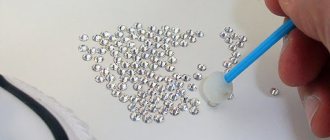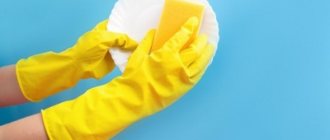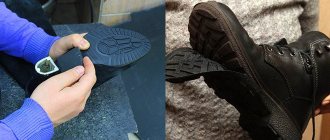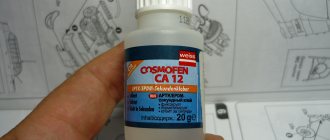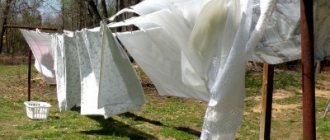Rhinestones have long gained popularity among girls as decorative elements on various items of clothing and accessories. However, decoration with rhinestones can not only be factory-made; you can independently diversify, refresh or emphasize the beauty of your clothes with purchased rhinestones. In this case, it is important to carefully and accurately attach the rhinestones to the surface.
In this article we will learn how to glue jewelry to fabric and select the appropriate glue.
Glue for rhinestones
The easiest way to glue rhinestones is with special glue. A correctly selected composition will ensure not only reliable fastening of the rhinestone, but also a beautiful appearance of the product.
- Epoxy resin is a universal adhesive for all types of surfaces except glass. When using this type of fabric glue, it must be remembered that the resin can leave noticeable marks and its final fixation occurs after many hours.
- Special fabric adhesive comes in airtight containers that have a pointed top. This allows you to carefully place the required amount of adhesive at the fastening site. After drying and hardening, the mass becomes transparent and invisible.
Water tests
And then after friction and stretching - water procedures! I soaked the samples in a cup without detergent for 10 minutes (my nod to synchronized swimming).
There is not a single rhinestone left on samples No. 2 Moment Crystal, No. 3 Fevicryl Fabric Glue and No. 4 Crystal Hobby. None. On samples No. 3 and No. 4, the glue absorbed the water, became white again and released all the stones, leaving no marks on the foil covering. Express removal of all inlay! Although, maybe someone will be interested in such a feature.
At Moment, although the glue did not dissolve, all the rhinestones still fell off.
The rest sailed several programs and did not “lose face.” These are samples No. 1 textile glue E6000 CRAFT, No. 5 UHU Power glue and No. 7 hot-melt rhinestones (HotFix) from Preciosa.
Wash
And my last mockery of the remaining samples is my favorite washing machine. According to tradition: each sample goes into its own sock and into a gentle wash cycle.
Only No. 7A hot-melt rhinestones (HotFix) showed themselves to be ideal. He did not part with a single stone! A very impressive result.
- No. 1 E6000 CRAFT also showed itself worthy. Only on the last round I lost two rhinestones;
- No. 5 UHU Power glue has lost more than half of its composition.
At this stage I again regretted that I could not find the Gutermann HT2. It seems to me that, given the demand, he could contribute to the treasury of positive reviews. Well, maybe next time, if there are a few more interesting names of glue.
What glue should I use to glue the rhinestones?
To achieve an ideal result, it is better to use special types of glue. Often the initial color of the glue is matte and white, this is necessary for ease of dosing.
It is not recommended to use adhesives containing acetone or acetic acid, as these substances can worsen the appearance of the products. Below are the common types of glue and their features.
Glue "Moment-Crystal"
It has an odor, which can negatively affect your well-being if you work with it for a long time. It has a transparent texture and is quite easy to apply. It stretches a little, but dries quickly on the surface to form a film. When applying decoration, a drop of glue may rupture and some of the liquid contents will fall onto adjacent areas of the material. The setting of the rhinestone occurs quickly and it is not possible to adjust its position.
Fevicryl Fabric Glue (India)
The bottle has a convenient applicator spout. The composition is based on epoxy paste (odorless, easy to apply, non-stretchy). The texture of the adhesive is initially white, which after drying becomes completely transparent.
After applying the rhinestone to the dried drops of glue, you can adjust its position within a few seconds. The adhesive sets quickly, does not lose its plasticity and does not deform the product. It is also convenient to work with on vertical surfaces.
Complete drying occurs within 24 hours. Using a household hairdryer will reduce waiting time.
A product with glued rhinestones can be washed in cold water after a week.
Textile adhesive E6000 CRAFT (USA)
Odorless, viscous, prone to the formation of threads between drops. Excess glue is easily and completely removed from the surface. The composition has high adhesion and forms a strong and elastic connection. This type of glue is especially often used for Swarovski rhinestones, since its composition is neutral to their foil surface. Also, its waterproof formula allows the product to be used in fresh water, sea water and machine washable.
Glue for rhinestones Danscouture (USA)
The emulsion is water-based and non-toxic. After drying, the glue becomes transparent and does not cause deformation of the surface of the fabric. Ideal for all textile fabrics, but not used for leather products.
Intended for gluing rhinestones with a flat bottom, popular in use for decorating the costumes of figure skaters, gymnasts and dancers.
Epoxy adhesive for Swarovski rhinestones CG 500-35 (USA)
This type of glue is widely used in the jewelry industry. At home, you can use it to independently decorate electronics cases with rhinestones, decorate various accessories, interior items, etc.
The adhesive composition demonstrates the highest adhesive qualities when working with various metal surfaces, synthetic materials, rubber, glass, porcelain or wood. This type of glue is not used for fabric; stains will remain.
Test one - "CARPET"
Each sample was slightly stretched and fixed onto a small paint roller and rolled for five minutes with pressure and periodic slipping over a piece of carpet (my greetings to rhythmic gymnasts).
Samples came out without loss:
- No. 1 E6000 CRAFT;
- No. 3 Fevicryl Fabric Glue;
- No. 7 Hot-melt rhinestones Preciosa (HotFix).
No. 2 Moment Crystal suffered the greatest losses.
Types of rhinestones
Depending on the material from which they are made, there are:
- Metal.
- Glass.
- Acrylic rhinestones.
Glass rhinestones or crystals are available with different lead or zinc contents, providing a different play of light. Acrylic rhinestones are made of plastic. Of course, cheaper and lighter than glass or crystal. Over time, they may become cloudy and lose their presentation during wear and washing.
Adhering to film-adhesive tape
A convenient method of application for large patterns of stones that are difficult to carry one piece at a time. The gluing process goes like this:
- The stones are placed on adhesive tape with the adhesive base facing up.
- The film is turned over onto clothing and ironed.
- The film is removed.
When attaching crystals in a large group at the same time, you must remember that not all rhinestones can grip equally well and some of them will fall off over time.
How to glue rhinestones onto fabric?
The general rule for gluing rhinestones to fabric is as follows:
- The required amount of glue is applied to the material. A drop of adhesive should spread and penetrate the surface of the fabric. To do this you need to wait a few seconds. Please note that thick fabrics will require more glue than thin ones. The volume of the drop should be such that a small amount of glue extends beyond the decoration, securely “enveloping” it around the perimeter.
- If you are working with elastic materials such as lycra , jersey or nylon , then the material must be stretched before gluing. When working with a finished product, it is recommended to place a thick sheet of cardboard between layers of material. This will prevent glue from getting onto the lower layers of the material.
- The stone should be picked up with tweezers, miniature forceps, a wax stick or a plastic stick with a drop of wax on the end, but not with your fingers. You can also pry off the rhinestones with a toothpick. The crystal is placed in the center of the drop, after which it should be pressed lightly.
You can apply glue directly to the rhinestone, but this requires skill and experience. Peeling the stone from the fabric if it is not placed correctly will leave marks and will look sloppy. Before working with a finished product, it can be useful to practice on a small area of unnecessary fabric.
Important! It should be remembered that thin fabrics such as organza do not hold rhinestones well. You should also not glue stones to any type of leather, including artificial leather.
How to properly glue thermal rhinestones?
To achieve a high-quality result, the following recommendations must be followed:
- — the product on which you are going to attach rhinestones, first clean it of any dirt;
- - if you plan to apply a complex design, first apply schematic markings to the fabric;
- — before starting work, stick one crystal onto a piece of fabric to see how well the adhesive adheres to the fabric.
Gluing thermal rhinestones using an iron
Gluing thermal rhinestones to fabric using an iron is not a difficult job if you follow a certain sequence of actions:
- - place the design on the fabric, it is important that there are no folds on the fabric at the moment when you glue the rhinestones;
- - when the pattern is completely laid out, cover the rhinestones with a sheet of white paper, then iron with a hot iron for 1-2 minutes;
- — when choosing the temperature setting for the iron, it is important to take into account the type of fabric so as not to spoil the product;
- - after completing the procedure, remove the paper, the glue should cool.
Glue thermal rhinestones using a rhinestone soldering iron
Not all materials can be ironed, so using an iron to glue rhinestones to leather, suede or velvet fabric will not work. In this case, you will need a special applicator. The soldering iron comes with attachments of different diameters that allow you to glue rhinestones of various sizes.
Step-by-step instructions for use:
— choose a nozzle of the appropriate size, it is important that the nozzle warms up the rhinestone completely;
— after the nozzle has been selected, connect the device to the electrical power supply, wait until the applicator warms up;
- distribute the material on a flat surface, check that there are no folds, lay out the design;
- use the applicator to press each stone onto the material for 3-5 seconds if it is small, and up to 20 seconds for a medium or large rhinestone.
Is it possible to glue rhinestones using a glue gun?
The glue gun has long become one of the everyday helpers; housewives use it to seal cracks in window frames, repair shoes and even plumbing fixtures. The gun not only connects plastic, wood, earthenware, and glass products, but also copes with gluing rhinestones to fabric.
The principle of operation of a glue gun is to heat and melt the glue stick. It will take no more than ten minutes for the heating element to melt the glue. Then apply a small amount of glue to a certain area of the product and stick on the rhinestone.
How to glue rhinestones with an iron?
This method is used for self-adhesive or hot-melt rhinestones (HotFix), when an adhesive composition has already been applied to the back surface of the stone.
First way
The task does not look difficult when the stones are the same size and are arranged closely on the product. They just need to be placed correctly, covered with gauze and gently ironed.
The iron temperature depends on the type of fabric. Excessive heating of the glass should be avoided so as not to cause deformation of the fabric. But at the same time, the heating must be sufficient, otherwise the crystals will not stick. Under the influence of heat, the adhesive penetrates into the fabric, providing a reliable connection.
Second way
It is necessary to place the iron with the sole up (for example, putting it on a stand for ironing sleeves). Place the rhinestones on the cold surface of the iron with the adhesive side up. Apply the desired pattern on paper. Place the sheer fabric over the design.
Heat the iron to medium temperature and wait for the glue to boil. Pry the needle and quickly transfer the stones to the fabric, turning them over. Use the free finger of the other hand to press to ensure tight contact of the hot decoration with the material.
For safety reasons, it is recommended to wrap your finger in cloth.
Alternative method of gluing using tape
This method is suitable for fixing a three-dimensional pattern, which involves the use of a large number of rhinestones. To do this, you should perform the following steps:
- Apply the design to the film and lay out the crystals along the contour. This is done on the sticky part. Place the stones with the shiny part facing the adhesive surface. As a result, the drawing turns out upside down.
- Cover the back of the crystals with glue and apply to clothing.
- When the composition dries, you should carefully remove the film. As a result, a pattern should remain on the fabric.
To check the reliability of fastening, shake the product a little. If some fragments fall off, it is recommended to glue them to the desired areas manually.
Using the applicator
There are fabrics that cannot stand the touch of an iron. For example, velvet. This is where a convenient soldering iron applicator with various attachments will come to the rescue. The attachments vary depending on the size of the rhinestone and allow you to heat the jewelry precisely and evenly.
The device itself is small and easy to use. The applicator will be indispensable for gluing individual hot-melt adhesive rhinestones. The device must be held still to accurately place the crystal on the fabric and ensure excellent results.
There are vacuum models of applicators that are equipped with a special pump; it draws in and holds the rhinestones.
How to securely fix the decor
If you purchased rhinestones that need to be glued cold, then you will need a special adhesive for the job. In some cases, it is enough to simply lay the stones on the clothes and use an iron to fix them. Craftswomen who make such decor to order use a special soldering iron. Replaceable attachments allow you to work with rhinestones of different sizes. The manipulation provides excellent results; the stones and glue warm up well, after which they will no longer be able to fall off even after washing.
A hot-melt glue gun fixes decorative elements with a special silicone compound, which melts and penetrates the fabric fibers, which ensures good adhesion. How to work with such a tool will be discussed below. Now we’ll tell you how to choose a composition for reliable cold fixation.
How to lay out rhinestones?
Before you begin the gluing process, you should lay out the desired design on paper or transparent tracing paper.
To transfer a design to fabric, you can use special crayons or pencils, traces of which can be easily removed from the surface of the material. It is recommended to wash the fabric itself or degrease it with alcohol before applying the adhesive. It is often convenient to fix the desired area in a hoop.
How to glue rhinestones to a swimsuit?
Gymnastics leotards are often decorated with rhinestones. Preference, as a rule, is given to large specimens so that they are noticeable from afar. Crystals are often laid out in the form of an original design.
Before gluing the decorations, the swimsuit should be stretched. You should start working from the periphery - sleeves, skirts and then move to the center of the product. Using a dispenser, apply the required amount of special glue (for example, Danscouture) directly to the swimsuit. The rhinestones need to dry within 24 hours.
Something about rhinestones
Decorative crystals are made from materials such as glass, plastic, ceramics, crystal and acrylic. There are many varieties of shiny beads:
- Transparent and colored.
- With a muted shine (“satin effect”) or glossy.
- With a flat or embossed bottom.
- Some types of rhinestones are not intended for gluing, but for sewing. They have special holes for threads.
Advice! The nature of the shine, the material of the base and the body of the rhinestone are important indicators. The more important the event for which the decor is being prepared, the more expensive the rhinestones should be. The most pretentious option, of course, is Swarovski crystals.
With the help of rhinestones, unique and bright things, festive outfits and sparkling accessories are created. You just need to practice a little, buy good materials and let your imagination fly. An assortment of multi-colored crystals will help turn an ordinary product into a unique thing.
Rhinestones are a means for decorating clothing, interior items, canvas, plastic and other surfaces. In order to make decorative trim with rhinestones, you don’t need any special skills, just take an iron and put in a little effort.
The glue on the shiny “bead” heats up and is fixed on the surface of the fabric or plastic when it cools. In this article we will tell you what types of rhinestones there are, methods of attaching them to surfaces, and how to glue them correctly.
Decoration with Swarovski crystals
Popular around the world, Swarovski crystals are a symbol of quality, impeccable style and cutting-edge design. Rhinestones are often used to decorate interior items, items of clothing or shoes, mobile phone cases, and various other accessories. For working on hard surfaces, it is better to use stones with a flat bottom.
Before decorating, it is necessary to thoroughly degrease the surface on which the crystals will be applied. They will be securely secured with a two-component epoxy adhesive, for example, CG-50-35. After applying the mixture to a grease-free, dry surface, quickly place and fix the crystals by lightly pressing on them.
When using Swarovski crystals with a hot-melt adhesive base, they should be placed on the material and ironed from the back.
What will you need?
Minimum effort, time and materials and tools:
- set of rhinestones;
- iron;
- item made of suitable fabric;
- several sheets of blank paper.
Advice! It is better to glue decorations onto a finished piece of clothing - cutting and sewing already decorated fabric is inconvenient. It is recommended to pre-wash the item, and immediately before work, remove dust particles and lint with a clothes roller.
Caring for products with rhinestones and crystals
Products with rhinestones certainly require careful care and delicate handling during washing and ironing:
- you should not soak such things;
- Hand washing at low temperatures is recommended;
- It is better to use liquid detergents for delicate fabrics;
- the use of conditioner is unacceptable, since the substances included in its composition significantly reduce the adhesion of the adhesive;
- during ironing, direct contact of the hot surface of the iron with decorated areas should be avoided;
- should be ironed through gauze or any other material.
Test Two: Extreme Stretch
Each knitwear sample was stretched as much as possible in different directions until it stopped without violating the integrity of the material. Imitation of the event if, during operation, the product got caught on something and was pulled strongly or was quickly and carelessly put on.
Samples continue to live:
- No. 1 E6000 CRAFT;
- No. 7 Hot-melt rhinestones Preciosa (HotFix).
They also performed well under such inhuman treatment:
- No. 5 UHU Power glue;
- #4 Crystal Hobby.
There is almost nothing left from No. 2 Moment Crystal and No. 3 Fevicryl Fabric Glue.
